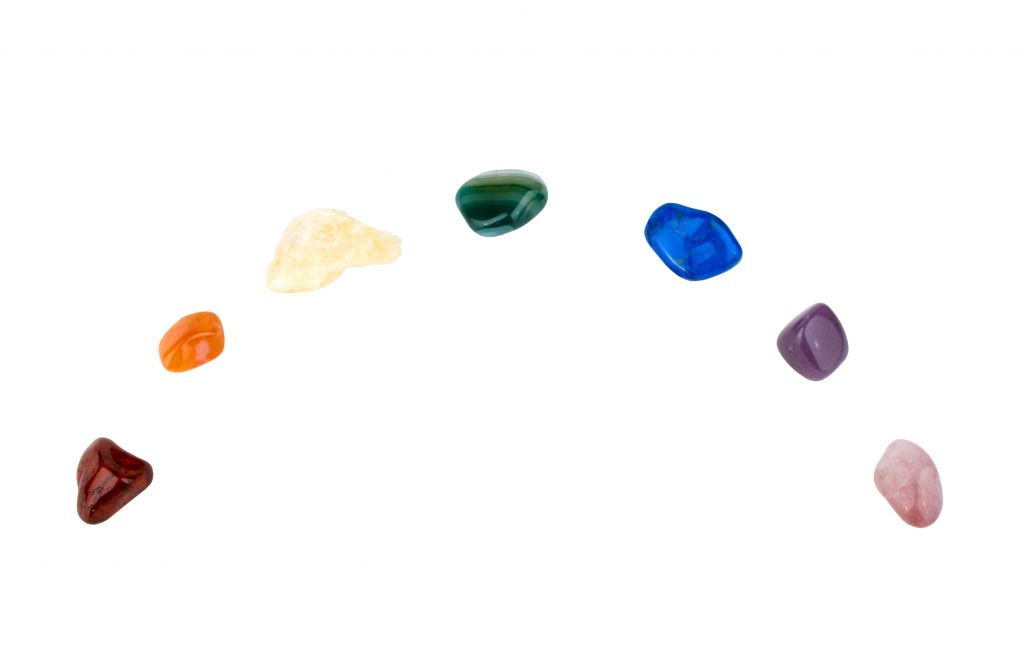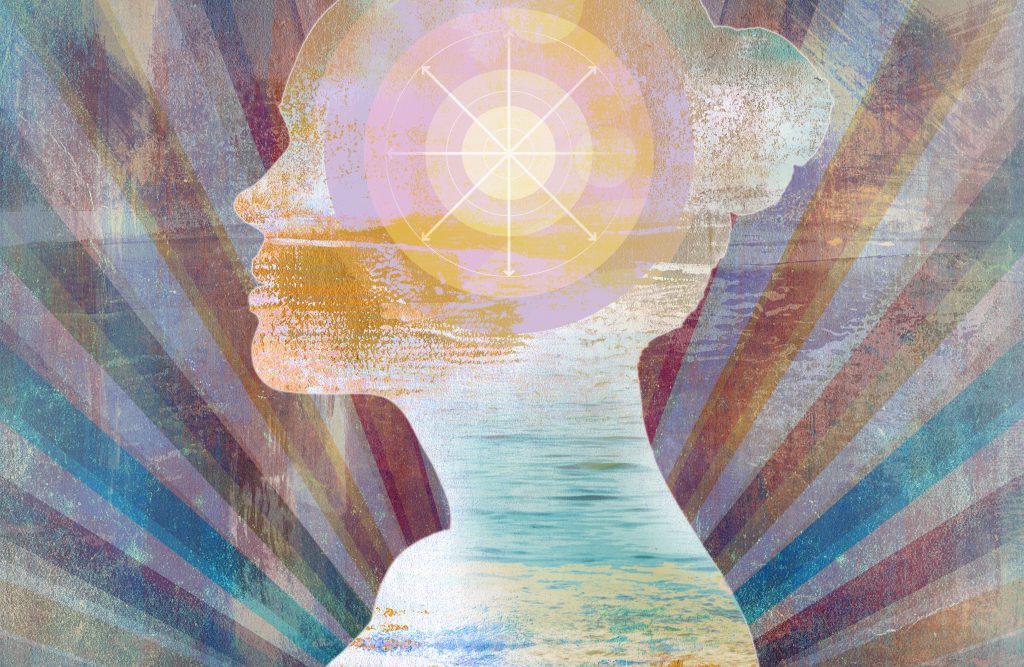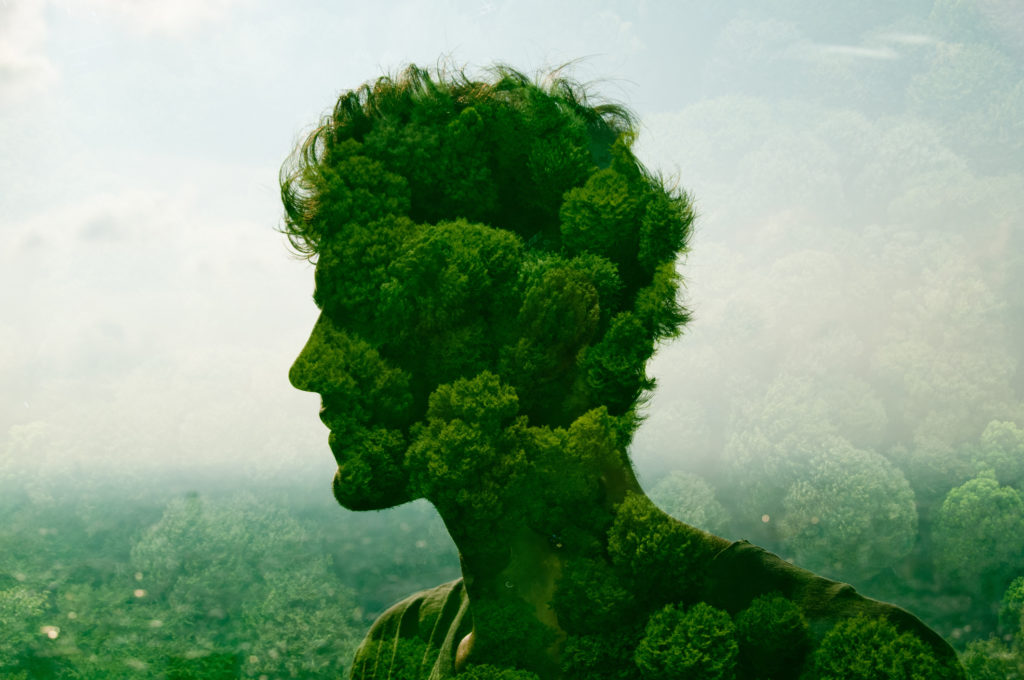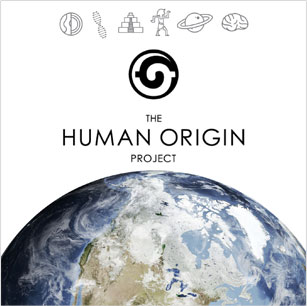The pineal gland, also called the third eye, was one of the last parts of the human brain to be fully understood.
Researchers have only recently begun to reveal the function of the pineal gland. Neuroscience for a long time focused on isolating the separate roles of the different brain parts.
However, the brain was found to have functional areas that work in groups rather than one part doing one separate job. The pineal gland is one of those multi-faceted areas.
It was well established that the pineal gland releases melatonin to direct circadian rhythms and sleep cycles. However, it’s now known to have a far broader purpose.
As a conductor of the endocrine system, the pineal gland controls hormone signals to all organs. It plays a dual neural-endocrine role with functions spanning into all bodily systems.
Today, evidence suggests the pineal gland is the master conductor of the physiology of the brain and body.
In this article, we’ll outline the history and advances in research that reveals what the pineal gland really does.
The pineal gland at a glance
- Located behind the third cerebral ventricle in the brain midline (between the two hemispheres).
- In adult humans, it is about 0.8 cm (0.3 inches) long and weighs approximately 0.1 gram (0.004 ounces).
- Rich supply of adrenergic nerves(neurons sensitive to the adrenal hormone epinephrine)
- In utero, it develops from the roof of the diencephalon, a section of the brain.
10 Functions and roles of the pineal gland
- Sleep and the circadian wake-sleep cycle
- Reproductive function and sex hormones
- Growth & development
- Body temperature
- Blood pressure
- Immune system
- Fertility
- Motor activity
- Cancer and tumor suppression
- Longevity and anti-aging
Part I: The Pineal Gland, Sleep & Melatonin Release
What is the pineal gland and why is it important?
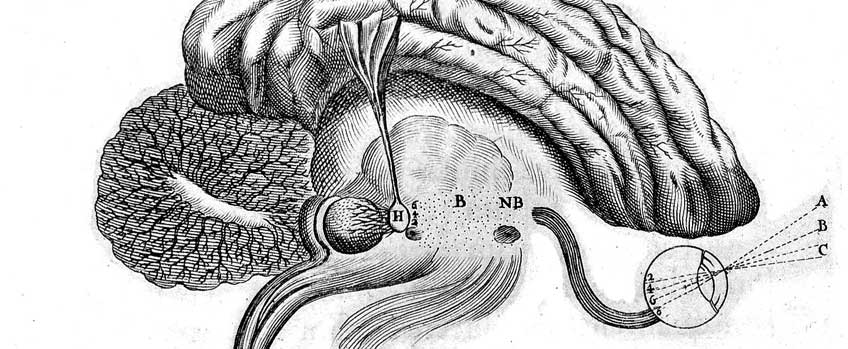
The pineal gland, located at the center of the two brain hemispheres, just above the third ventricle. Source
The pineal gland also called the pineal body, or third-eye is a pine cone shaped gland. It is pea-sized (1/3rd of an inch) lying deep at the center of the brain in the epithalamus.
With a reddish-gray color, it is primarily made up of pineal cells and neural support cells.
Sitting on the roof third ventricle of the brain, it lies directly behind the root of the nose. Here it floats in a small lake of cerebrospinal fluid.
Recently, scientists have pieced together the role of the pineal gland as the master regulator of the body. A close partner of the hypothalamus, it behaves as a bridge between the nervous and endocrine (hormone) system. It also works with the limbic system to balance emotions and other rhythms throughout the body.
The pineal gland is critical for day/night sleep cycles, hormone balance, and the immune system.
Let’s explore how such a tiny part of your brain is so important throughout the body.
How did the pineal gland get its name?
Pinea is a Latin word for pine cone. The pineal gland is shaped like a very tiny pine cone.
The Greek philosopher and doctor Galen was the first to describe it as glandula pinealis. He would identify its anatomy as sitting in the ventricles of the brain. Later Greek philosophers proposed the pineal gland allowed thoughts to resonate through the ventricles of the brain.
In 300 BCE, the Greek physician Herophilos nominated it as the brain’s only unpaired organ.
Later, René Descartes described the pineal gland as a unique meeting point between body and soul. He also described it where all ‘thoughts are formed’.
What is the main function of the pineal gland?
The best-known function of the pineal gland is to regulate sleep and day-night cycles. It allows the brain to detect whether there is light in the environment.
It’s these properties that make the gland cross between neural and endocrine systems. The detection of light stimulates the natural melatonin cycle.
Melatonin is a hormone that regulates sleep, amongst many other roles in the body. It is released by the detection of light from the outside world.
The pineal gland acts as a ‘biological clock’ in humans, and as we will discover, much more.
Why is the pineal gland called the third eye?
Here are three reasons why the pineal gland is known as the third eye.
- The evolution of the pineal gland describes its links to the mammalian third eye where the gland directly detects light.
- It contains rod-like cells that are very similar to those in the eye.
- It is connected to the eyes in a pathway to detect light and release melatonin.
Structure of the pineal gland
The pineal gland has a very unique cellular structure. Only recently has the chemical make-up and nature of pineal cells as an endocrine in function been isolated.
Its main cell type are pinealocytes which are unique cells to the pineal gland. While derived from the same embryonic origin as other brain parts, they are not classical nerve cells. They are classed as endocrine cells that secrete hormones in response to neural stimulation.
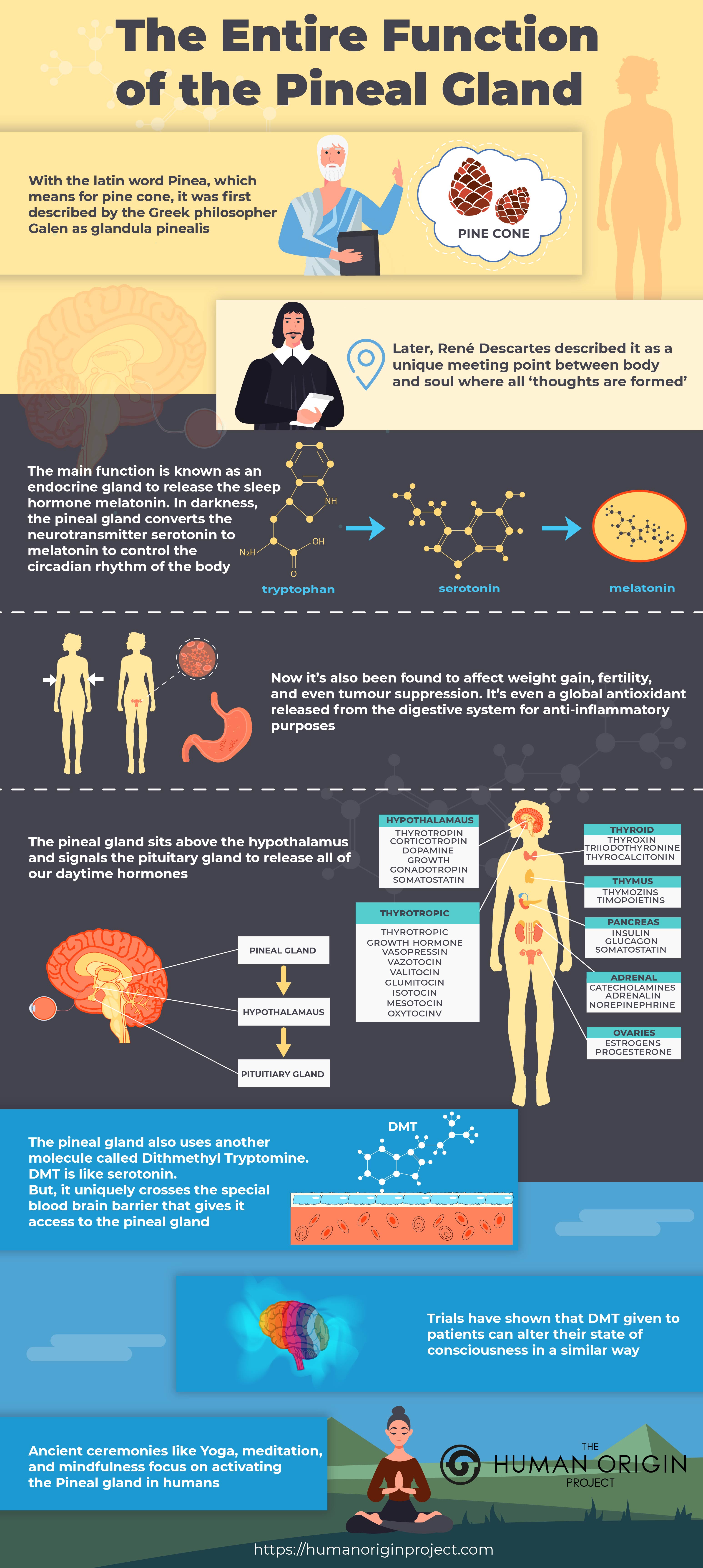
The cross-system function makes the pineal gland wholly unique. Pinealocytes are the way your body detects light from the world. It helps the brain create a ‘biological clock’ to manage sleep and wake cycles.
They detect a neural message of light from the eye then convert it to a chemical and hormonal response. Pinealocytes produce melatonin and other hormones in response to light. They have extensions that mingle with adjacent neural cells to project their messages.
Four types of cells conduct the cross of neural and endocrine functions of pinealocytes.
- Light pinealocytes – These are the most numerous pinealocytes. They contain the neurotransmitter serotonin. Serotonin is converted to melatonin.
- Dark pinealocytes – The cells that contain melatonin and are thought to have similar characteristics as endocrine and neural cells.
- Synaptic ribbons – Small organelles found in pinealocytes. They likely help with light detection and secretion of hormones.
- Astrocytes – Pinealocytes are connected to the brain via neural support cells. These are slightly different to astrocytes present across the brain. In the pineal gland, these cells also interact with surrounding blood vessels to make a special barrier. It’s known as the blood-pial barrier.
Here the pineal gland releases melatonin into the bloodstream.
The third-eye, light-dark sleep function of the pineal gland
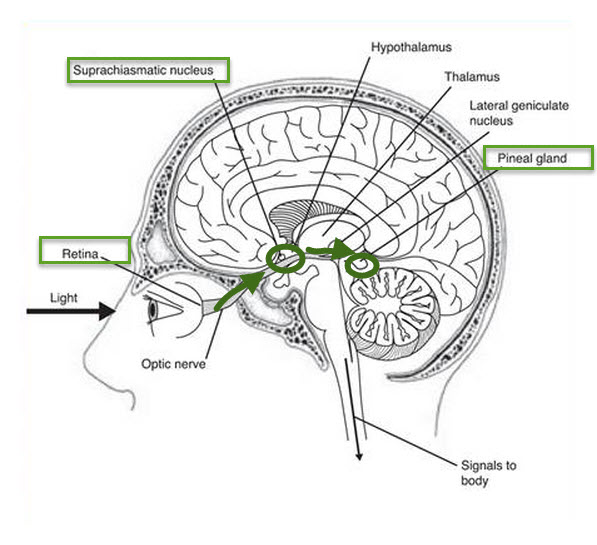
The proposed neural pathway of light detection and circadian rhythm management of the pineal gland. Source
The pineal gland acts like a third-eye by detecting light and releasing a hormonal response. It allows the body to respond to light-dark cycles of day and night on earth.
Light begins a sympathetic nerve pathway in the pineal gland in four steps:
- Light is detected in the receptors of the retina of the eye.
- A neural signal projects to the suprachiasmatic nucleus (SCN) in the hypothalamus.
- Neurons in the suprachiasmatic nucleus release norepinephrine to configure the internal circadian rhythm.
- The pathway decreases the release of melatonin from the pineal gland.
Natural melatonin release from the pineal gland
During darkness, the pineal gland releases melatonin. If you think about the brain and organs in the body, they see melatonin as a signal from the world. Melatonin means darkness.
When the eye detects light, it sends a neural signal back to the hypothalamus-pineal pathway.
Pinealocytes store the neurotransmitter glutamate in special packages known as vesicles. When they receive stimulation from light, they release glutamate.
Glutamate decreases the release of melatonin from the pineal gland.
Light signals decrease melatonin release to indicate that it’s daytime.
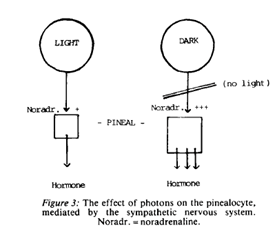
Natural melatonin release in response to the absence of light. Light signals from the eye cause the release of glutamate in the pineal gland that decreases melatonin release. Source
How does melatonin work?
Melatonin is the main hormone released from the pineal gland. It acts as the master clock of the body. While regulating the circadian rhythm, it also directs growth, slows aging, and promotes mental stability.
As light stimulates the pineal gland, blood levels of melatonin fall, making the body feel awake. When darkness arises in the evening melatonin release increases. Blood levels of melatonin rise and the body prepares for sleep.
How melatonin affects sleep
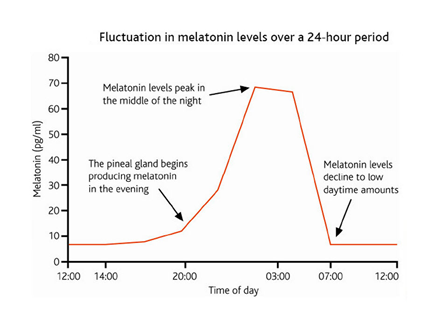
Melatonin affects sleep through levels in the blood that impact body temperature, blood pressure, and hormonal levels.
Melatonin guides the bodies diurnal rhythm by two factors.
- The circadian clock: drives the rhythm of sleep – melatonin entrains the circadian clock to know when it is light and when it is dark.
- The sleep process: where the body falls asleep – melatonin assists the process of falling asleep by calming, cooling, and relaxing the body.
Melatonin rises and falls alongside the rising and setting of the sun.
The pineal gland detects light through the eyes and hypothalamus. As you are exposed to more sun throughout the day, melatonin decreases.
In the evening, when it gets darker the secretion of melatonin increases again. Melatonin affects blood pressure, body temperature and hormone levels. By cooling, calming and regulating the body, it helps to begin the process of sleep. It also decreases excitatory neurotransmitters in the eyes and brain.
Outside processes can change the circadian rhythm. The sleep-wake cycle follows the 24-hour solar day. Taking oral melatonin can for example change circadian rhythm cycles.
Light medication can also change the release and melatonin levels. Taking melatonin for sleep in the evening the onset of drowsiness. However, it may reduce the release of melatonin in the long term.
What hormones are secreted by the pineal gland?
While most known for melatonin, the pineal gland manages and secretes many hormones. It contains many hormones called biogenic amines. These include:
Catecholamines
- Noradrenaline
Indoleamines
- Serotonin
- Melatonin
During the daytime, it produces serotonin, which we know keeps us happy and buoyant. At night the serotonin is converted into melatonin.
Along with their enzymes, these hormones control sleep alongside light cycles.
Both are made from the amino acid tryptophan. Enzymes in the pineal gland help the hormone pathway.
Tryptophan -> Serotonin -> Melatonin
How does serotonin affect sleep?
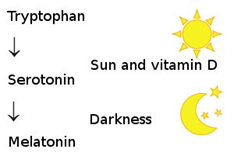
Serotonin levels in the pineal gland decrease as the body prepares for sleep.
The pineal gland creates the balance between melatonin and serotonin. Melatonin is made from serotonin.
When melatonin levels rise, serotonin in the pineal gland decreases. However, it doesn’t happen immediately. Serotonin begins to decline four hours before melatonin release increases.
The pineal gland begins to convert serotonin in response to darkness. When the eye is exposed to light, it triggers the release of vitamin D which helps convert tryptophan to serotonin.
Serotonin is converted to tryptamine and then to melatonin once it is dark. It is a cascade that takes time once darkness begins in the early evening. The rise of melatonin happens 4 hours after the decrease of serotonin.

Tryptophan is made into serotonin that converts to melatonin to control the sleep cycle. Source
Part II: The pineal gland as the master hormone regulator in the body
Previously, researchers thought the hypothalamus was the master conductor of the endocrine system. There are many reasons for the confusion regarding the function of the pineal gland.
The main reason was that the pineal and pituitary gland relationship was poorly known. Pituitary function was understood by diseases. If a disease caused reduced levels of hormone release from the gland, the endocrine pathway was established.
However, because pineal cysts or disorders don’t produce hormone deficiency, it was assumed it didn’t affect the endocrine system.
Today we now know the pineal gland sits above the hypothalamus to control endocrine hormones.

The pineal gland is the master gland of the endocrine system. Source
Pineal -> Hypothalamus -> Pituitary -> Endocrine glands
What is the pineal gland responsible for?
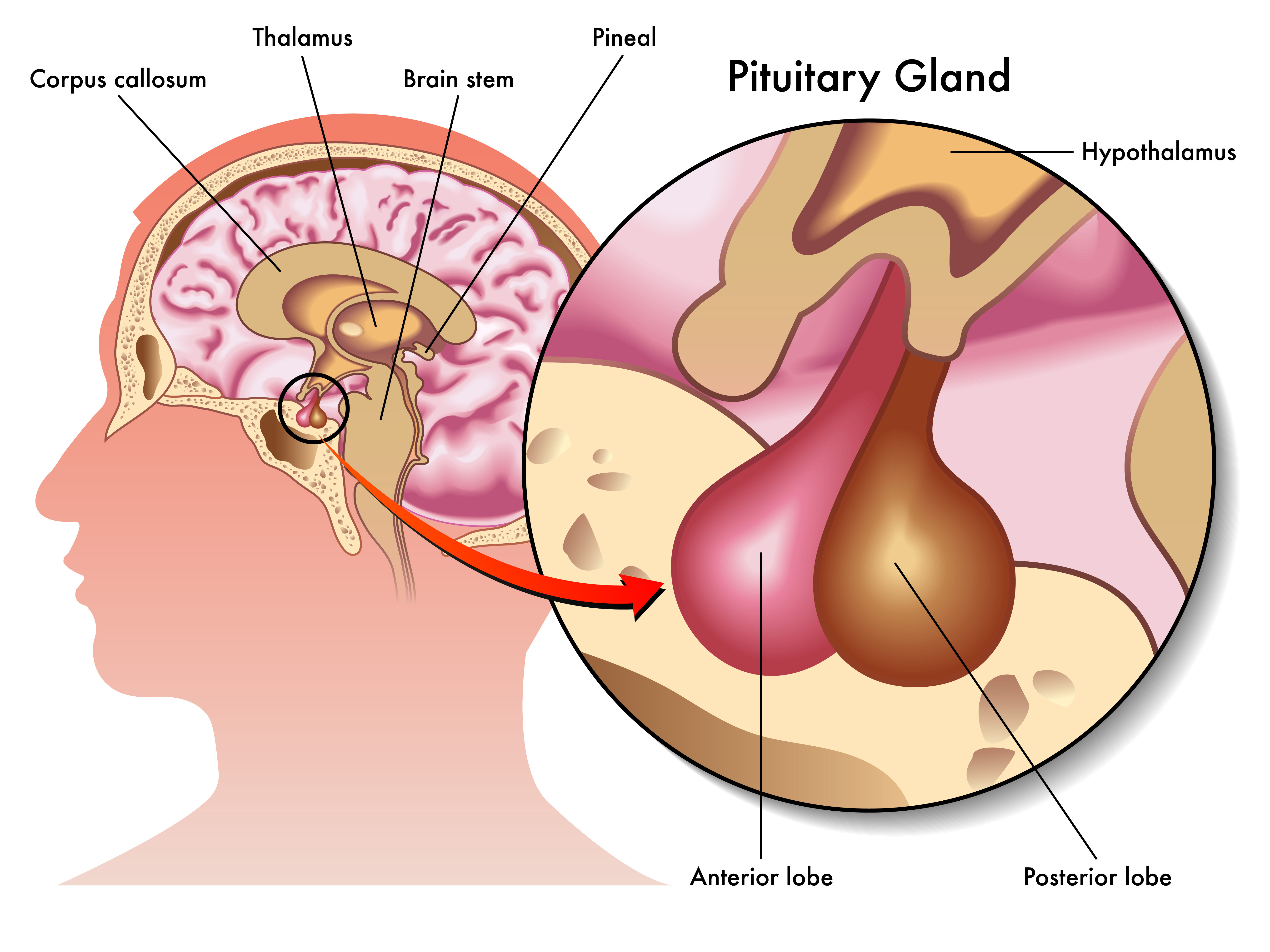
The pineal gland is responsible for hormone release from the two lobes of the pituitary gland. Source
As the master conductor of the body, the pineal gland is responsible for hormone release from the pituitary gland.
The pituitary in turns signals the rest of the endocrine system. These organs then release hormones based on the signal from the pituitary.
If the pineal gland is removed via pinealectomy, the anterior pituitary gland swells or becomes larger.
Endocrine glands signaled by the pituitary:
- Thyroid gland (thyroid hormone for cell turnover)
- Adrenal gland (cortisol or stress hormone)
- Thymus (thymosin for immune cells)
- Pancreas (insulin for blood sugar balance)
- Ovaries and testicles (sex hormones)
- Some non-endocrine organs inthe body
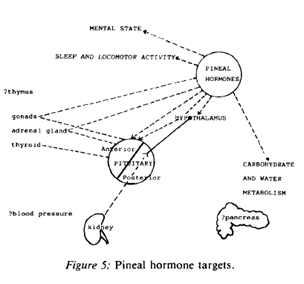
The pineal gland signals the hypothalamus, pituitary glands, and all other glands in the body.
9 hormone roles of the pineal gland in the body
As the master endocrine gland, the pineal gland oversees nearly every bodily process.
1. Growth and development
Growth is known to happen during sleep. Melatonin released by the pineal gland regulates growth hormone release. The pineal gland influences the hypothalamus that signals growth hormone from the pituitary. Oral melatonin can increase growth hormone levels. (1)
2. Body temperature
As part of the circadian rhythm, body temperatures drop exactly when melatonin levels peak. The pineal gland directs the pattern of body temperature associated with daytime height in body temperature. When melatonin is high, body temperature is at its lowest for sleep. (2)
3. Blood pressure
Sleep cycles associate with blood pressure. Circadian rhythm works with the heart rate and the cardiovascular system. Melatonin helps the body to regulate blood pressure levels. Studies have shown that high pressure or hypertension can be reduced with daily oral melatonin. (3)
4. Water balance
Water balance is regulated by antidiuretic hormone (ADH) or vasopressin. It is released from the pituitary gland.
ADH regulates osmotic pressure of body fluids by causing the kidneys to increase water reabsorption. It’s released from the hypothalamus and stored in the posterior pituitary gland. When secreted into the body it signals the kidneys to store water via concentration of salts in urine.
In rat studies, pinealectomy shows the levels of ADH or vasopressin were elevated (4). Melatonin decrease these levels, showing the pineal effect on water balance in the body.
5. Metabolism and weight gain
Melatonin binds to receptors in the pancreas to suppress insulin secretion. It’s thought the main reason is to keep blood glucose levels steady during an overnight fast (sleep).
Insulin plays a role in carbohydrate metabolism, weight gain, and insulin resistance is the mechanism in type-II diabetes. (5). Diabetes insipidus has been noted to occur with pineal tumors. Melatonin is also known to reduce levels of leptin, the hormone that shifts the body to store fat.
People who eat diet’s high in simple sugars and carbohydrates may affect their melatonin levels. Insulin allows clearance of all amino acids except one, tryptophan.
6. Fertility and reproduction
The pineal gland affects the release of the sex hormones. It’s well known that in animal systems that melatonin plays a role in reproduction. The anterior pituitary gland releases two hormones.
- Luteinizing hormone (LH)
- Follicle-stimulating hormone (FSH).
In males, these stimulate the testes to release testosterone. In females the ovaries to release estrogen.
Studies have shown that in blind women, menstrual cycles begin earlier. In men, melatonin can influence testosterone release.
Lack of light can create fertility problems in both men and women. (6)
7. The immune system and tumors suppression
The pineal gland regulates the immune response. As the head of the neuroendocrine system, it oversees two-way crosstalk with the immune system.
As the immune system detects foreign threats in the body, it relays it to the pineal gland. The pineal gland then directs a response to the environmental toxin. It’s a language that works via melatonin as well as a host of neurotransmitters and hormones. These can produce antibodies, natural killer cells, and mitogens with the ability to kill pathogens.
In cancer and tumors, the pineal gland receives the message of its presence. Melatonin activates the immune defense process for tumor-inhibitory activity. (7)
8. Anti-aging and anti-oxidant activity
Oxidative stress is one of the main mechanisms of aging. Melatonin is also a powerful anti-oxidant. Its strength against oxidation is noted against better-known anti-oxidants.
Melatonin has been found to possess 200% more antioxidant power than vitamin E. Melatonin has also been found to be superior to glutathione as well as vitamins C and E in reducing oxidative damage. (8)
9. Depression, anxiety, and mental health
Mood disorders such as depression and anxiety may have common cause in melatonin receptor dysfunction. The balance of neurotransmitters serotonin and dopamine is known to have a role in mental health. The pineal gland mediates these hormones and their effect on mood in the brain.
Serotonin is converted to melatonin in the pineal gland depending on the light-dark cycle. Disruption in the circadian rhythm is associated with depression and anxiety symptoms. Dopamine levels are thought to be related to melatonin. (9)
Part III: The pineal gland and DMT
Despite the progress of the last 20 years in understanding the function of the pineal gland, there are still big unknowns.
One remaining mysterious element is the role of DMT. Researchers are only beginning to understand the role of the neurotransmitter and its effect on the brain and body.
DMT (N, N-dimethyltryptamine) has a known psychedelic effect on people who take it. There is also increasing evidence that DMT is produced in the pineal gland.
Much research is required, however, the role of the pineal gland as the third eye seems to be linked to DMT in the brain.
What is DMT?
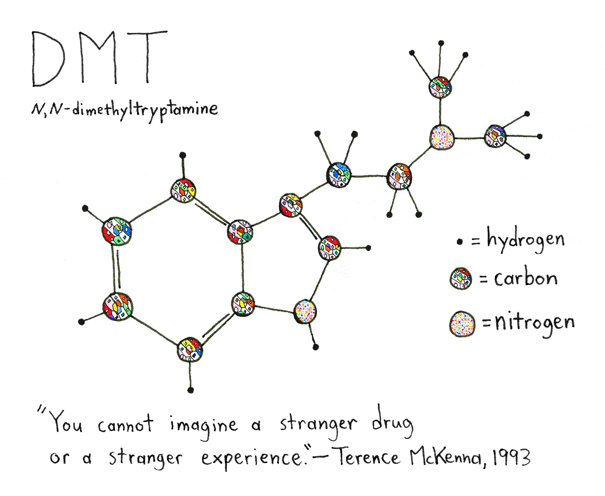
The chemical structure of DMT (N, N- dimethyltryptamine) and it’s known psychological effects on taking oral doses. Source
DMT was first isolated as a chemical about 100 years ago. It is found in many plants. Later, it was discovered to be naturally occurring in the human body.
It’s a tiny molecule with a weight of 188 ‘molecular units,’. The simplest sugar in our body, glucose is (180 units). DMT is barely larger.
In the brain, DMT has similar chemical properties to serotonin. Serotonin is a neurotransmitter that has many roles in the body. It controls mood such as anxiety and happiness, but also the digestive system including bowel movements.
Structure of DMT and serotonin

The chemical structure of DMT is similar to serotonin, a neurotransmitter found in the pineal gland.
There is a critical difference between serotonin and DMT. Serotonin is not transported across the blood-brain barrier (BBB). There are very few substances that contain this ability. It’s the most tightly regulated barrier in the human body.
However, in the 1970s, Japanese scientists discovered that DMT travels across the blood-brain barrier into the brain.
The transport doesn’t happen passively. It’s now known DMT is actively transported across the blood-brain barrier. That means there are transporter cells designed specially to let DMT into the brain.
Where is DMT found in the body?
DMT is found in large quantities in cerebral spinal fluid. It’s understood to be produced in the lungs and the eyes. It’s also known to be produced in various amounts throughout the body.
Does the pineal gland produce DMT?
While yet to be confirmed, there is evidence to suggest the pineal gland produces DMT.
In animal studies, DMT has been found to be released in the pineal gland of live, freely moving rodents.
Like other molecules produced in the pineal gland, there is a pathway of production.
Tryptophan -> Tryptomine (TA) -> Methyltrytamine (NMT) -> DMT
The last step requires a substance called indole-N-methyltransferase. (INMT)
Studies have revealed that INMT is present in high concentrations in the pineal gland. There is also a response to INMT application to the brain.
The direct evidence of DMT production in the pineal gland is yet to be confirmed. However, scientists are close to understanding its role and source in the brain.
One problem suggested, however, is whether the human pineal gland can produce enough DMT to create an effect. For example, a psychedelic experience would require 25mg of DMT. A big task for the tiny pea-sized pineal gland.
It’s unknown whether DMT experiences are the primary purpose of DMT in the body.
What does DMT do to your brain?
In the 1950s through to the ’90s, DMT in the body was thought to cause mental health disorders like Schizophrenia. Studies, however, showed little variation between DMT in normal and psychotic illnesses.
Later it was found to be far more fundamental to the brain. In animals, studies suggest DMT may even be crucial to the development of the brain.
Researcher Rick Strassman began research into the effect of DMT on the brain. His clinical trials recorded patients describing similar out of body experiences on dosages of DMT.
The exact mechanisms of these effects are unknown. As are the roles for a number of related receptors in the brain. These include the 5HT2A receptor, which DMT and related hallucinogens may influence.
There are a set of receptors called Sigma-1 that control channels in the brain. Studies show that substances that activate sigma receptors influence animal behavior. DMT has also been found to affect immune responses through Sig-1R under various conditions.
Other research suggests the role of DMT in different states of consciousness. As the pineal gland controls melatonin and sleep cycles, DMT could be related to states of consciousness during sleep and dreaming.
DMT has been tested in clinical trials as well as the psychedelic plant medicine, Ayahuasca. The Peruvian ceremonial tea delivers a digestive form of DMT. In both situations, people report a wide variety of difficult to describe experiences.
The neurobiology of psychedelic states and night dreams have overlapping features. Studies have looked at global gamma waves in the brain during peak DMT trials.
Research has also looked at the role of global gamma coherence during peak DMT experiences. A link between theta brain waves, the perception of happiness, and lucid dreaming may also reveal interesting connections.
What does DMT do to your body?
DMT is produced throughout the body, all the time. The digestive system, however, has enzymes designed to deactivate DMT.
In the human gut, DMT is broken down rapidly by metabolism by monoamine oxidase (MAO).
Ayahuasca is a combination of B. caapi and the alkaloids harmine, harmaline, and tetrahydroharmine. They all belong to the same chemical family, which implies they are MAO-inhibitors.
A variant on DMT 5-MeO-DMT is a molecule of the tryptamine class. It’s known to be isolated from at least one toad species, the Sonora Desert toad.
DMT treatment has been studied for conditions such as:
- Depression
- Obsessive-compulsive disorder
- Psychological impact of terminal illness
- Drug addiction
- Alcohol addiction
- Post-traumatic stress disorder (PTSD)
Conclusion:
For a long time, the function of the pineal gland was a mystery. Today it is established as the master conductor of the neural and endocrine system.
With cross-function of melatonin, sleep, and endocrine hormone release there are few processes in the body the pineal gland does not influence.
To learn more you can read these articles:
- Decalcify the pineal gland and open the third eye.
- What is melatonin?
- How to use melatonin for sleep
- What is melatonin used for?
Now it’s up to you. What have you learned about the pineal gland that you found most interesting? Leave your thoughts in the comment section below.
Further reading:
- https://www.ncbi.nlm.nih.gov/pubmed/180879
- https://www.researchgate.net/publication/285615047_The_allegory_of_the_konarion_A_philosophical_history_of_the_pineal_organ_from_galen_to_descartes
- https://plato.stanford.edu/entries/pineal-gland/
- https://www.ncbi.nlm.nih.gov/pubmed/180879
- https://www.hindawi.com/journals/bmri/2013/618432/
- http://www.jneurosci.org/content/27/43/11748
- http://science.sciencemag.org/content/330/6002/379
- https://www.ncbi.nlm.nih.gov/pubmed/17383936
- https://www.ncbi.nlm.nih.gov/pubmed/22371425
- https://www.ncbi.nlm.nih.gov/pmc/articles/PMC2947205/
- https://www.ncbi.nlm.nih.gov/pmc/articles/PMC4828992/
- https://www.psychologytoday.com/au/blog/unique-everybody-else/201408/dmt-gateway-reality-fantasy-or-what


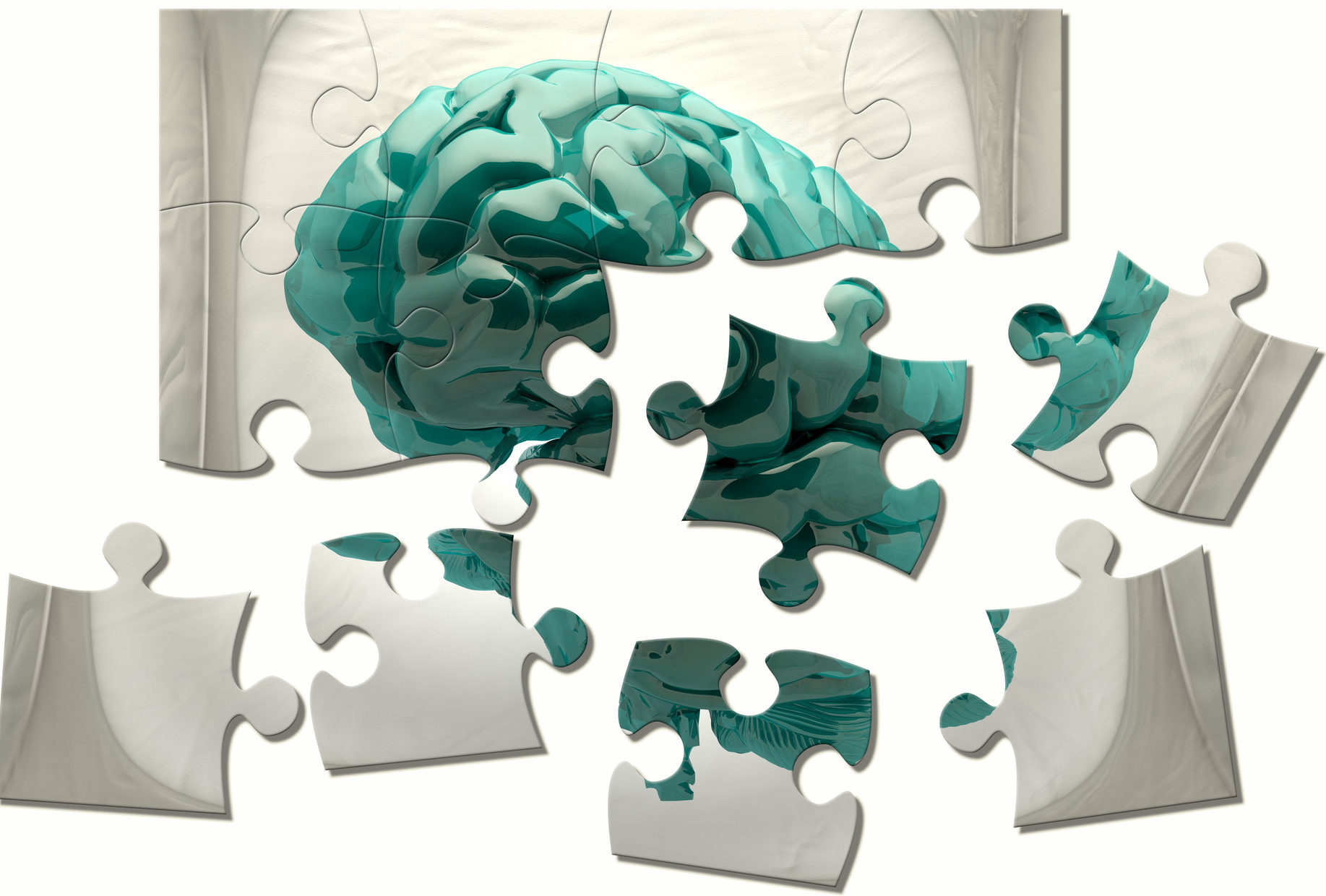 The function of the pineal gland was for a long time thought to be only related to the release of melatonin.
The function of the pineal gland was for a long time thought to be only related to the release of melatonin. 